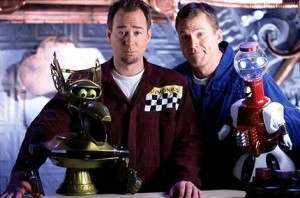
TO the delight of virtually everyone, the late, great Mystery Science Theater 3000 (1988 – 1999) seems to be experiencing something of a pop culture resurgence these days.
April 1st of this year saw former Mystery Science Theater 3000 stars Mike Nelson, Bill Corbett and Kevin Murphy return to top form in National Geographic’s Total Riff-Off, and the cable network Retro TV recently announced that it will begin airing MST-3K reruns starting July 5, 2014.
Among other triumphs, the award-winning Mystery Science Theater 3000 brought attention to some of the world’s most unbelievably bad and obscure movies, like Manos, The Hands of Fate (1966), Red Zone Cuba (1966), Wild World of Batwoman (1966) and Space Mutiny (1988).
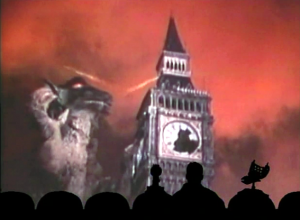
Yet the brand of negative, mocking attention that an MST-3K spotlight could bring was also capable of irreparably harming a movie’s reputation, and sending its IMDB scores plummeting.
Over the years, several movies that had — before Mystery Science Theater 3000 — not been considered half-bad, saw their reputations altered forever for the worse after they were included on the program.
With that idea in mind, let’s gaze at five science fiction films featured on Mystery Science Theater 3000 that are much better than their presence on this beloved and legendary “bad movie” series suggests.

1. Phase IV (1974) (MST3K Season 1, Episode 9; January 15, 1989)
This film was the directorial debut of one of cinema’s foremost graphic designers and storyboard artists, Saul Bass. The film involves a strange “change” in the Earth — perhaps wrought by unseen aliens — that renders the planet’s ant population intelligent and cunning.
Phase IV makes pervasive and remarkable use of close-up natural photography of the ants, courtesy of accomplished photographer Ken Middleham. There is no Hollywood trickery (or CGI…) involved in these amazing, lengthy sequences, simply real ants going about their business with frightening dedication and focus.
One sequence here — wherein an ant attempts to carry back to the Queen a piece of the pesticide that has killed his brethren — proves awe-inspiring both in terms of execution and thematic expression. Exposure to this pesticide chunk is fatal to the warrior ant, but he marches along, as far as he can, nonetheless. When he expires, another soldier ant arrives and continues the journey where he left off. When that ant dies, another ant arrives and continues the journey a step further.
Uninterrupted by human interaction or comment, this march endures until the last ant gets the chunk of poison to the queen, and she very quickly is able to create immunity to the weakened poison in future generations as she lays eggs. We see here a different brand of intelligence from our own; one that puts the well-being of the community over the well-being of the individual, and that’s one of the movie’s key themes.
Another scene of incredible visualization involves the ants lining up their dead after an attack by humans. They lay the corpses out in rows, belly up…and then stand at a form of attention; as if honoring their dead at a funeral. Again, one can’t help but consider how “human” these ants seem in their apparent capacity to mourn.
Throughout the visually-dazzling Phase IV, Bass determinedly grants the ants and their side in this war as much screen time as the human stars, and the effect is both startling and unsettling. One starts to wonder which species is altruistic and which is warlike; which species understands love and which species doesn’t.
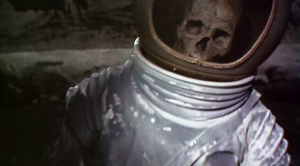
2.Moon Zero Two (1969) (MST3K Season 2, Episode 10, January 30, 1990)
Though not exactly scintillating in terms of pacing or narrative clarity, Moon Zero Two — which was billed as the first space western — nonetheless adheres well to it thematic point. And that point is simply that no matter what frontier or horizon he broaches, man remains the same animal as he is right here on Earth. The “dream” that drives his conquest of new territories is not Star Trek-like exploration, but the opportunity to get rich quick.
This very idea of commercialism on the final frontier is diagrammed in the lead character’s existential crisis. The movie is set just a few decades into the future, and Astronaut Bill Kemp (James Olson) — the first man to set foot on Mars — doesn’t wish to spend the rest of his life ferrying passengers to and fro, so he becomes an independent “pilot for hire” above the moon instead.
In other words, the explorer’s job is done, and now business interests and regulations dominate the arena of space. Kemp will be ousted even from his modest living because the Establishment has deemed his old spaceship unsuitable for safe flight. In truth, this regulation is actually but an attempt to keep him from staking a claim on anything valuable he might find on the lunar surface, or in orbit.
For all its flaws, Moon Zero Two returns again and again to symbols that directly critique the idea that man — even when he goes to the stars — must take unfettered avarice and greed with him. There’s a board game called “Moonopoly” in evidence, for example, about the divvying up of the natural satellite’s resources, and at one point, the audience learns that a businessman has resorted to murder so he can stake a claim on a jeweled asteroid.
Produced by Hammer Studios, Moon Zero Two boasts some impressive sets, as well some remarkable miniature landscapes and vehicles from the great Les Bowie, an effects artist who contributed also to First Men in the Moon (1964), and Superman: The Movie (1978). Although it is true that — forty-four years later — Moon Zero Two’s effects appear dated, they were, at the time of their release, state-of-the art.
While it is plainly no 2001: A Space Odyssey (1968) — or Journey to the Far Side of the Sun (1969) — for that matter, Moon Zero Two is nonetheless a good-faith attempt to diagram the parameters of a near-Earth “space age,” and comment on man’s unchanging, avaricious nature.
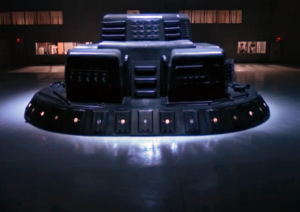
3.Hangar 18 (1980) (MST3K Season 1, Episode 19, March 14, 1989)
Although undeniably a low-budget effort, James Conway’s Hangar 18 reflects with excitement and terror the Zeitgeist of the late 1970s and early 1980s. In other words, this is a science fiction/horror film concerning government conspiracies (like Watergate), the ancient astronauts of Von Daniken’s Chariots of the Gods, and even fears of NASA cover-ups about man’s place in space (like Capricorn One [1978])
A forerunner to The X-Files (1993 – 2002), Hangar 18 depicts the tale of two NASA astronauts, Lou Price (James Hampton) and Captain Steven Bancroft (Gary Collins) who spot a UFO during their shuttle mission. A third member of their crew dies (in one of the film’s grisliest visuals…) when the alien craft interferes with the launch of a military satellite.
Back on Earth, however, a President seeking re-election would rather blame the astronauts for their comrade’s death than raise the specter of UFO incursions on planet Earth. When the UFO is captured, however, it promises to reveal secrets not only about space, but about mankind’s very origins…
Today, Hangar 18’s virtues remain as visible as its budgetary deficits. The film expertly creates a feeling of growing paranoia, and there are at least three “jump scares” that remain highly effective. Revelations about the aliens’ connection with mankind are also genuinely intriguing.
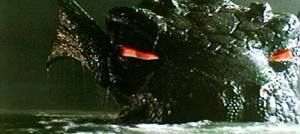
4. Gorgo (1961) (MST3K Season 10, Episode 9, July 18, 1998)
Mystery Science Theater 3000 actually had film critic Leonard Maltin guest star in this episode of the series, and he confessed to the series stars that he liked Gorgo — a giant monster movie — a lot. Other critics felt the same way about this British monster movie.
For instance, in A Pictorial History of Science Fiction Films, author Jeff Rovin termed the film “one of the finer efforts of this sort,” and noted that there is “a great feel for British locale in Gorgo…The special effects are superb, and Gorgo is tactfully kept in shadow throughout most of the film, which enhances the mood while making the special effects much less obvious.”
Thematically, Gorgo also demonstrates tremendous fidelity to the spirit of the kaiju films of Toho and Ishiro Honda. In many Godzilla films, Godzilla himself (or his opponent…) represent the revenge of nature after mankind has egregiously sinned. Godzilla is “born” of atomic radiation, following testing of A-bombs, for example. Hedorah in Godzilla vs. The Smog Monster (1972) is nurtured on our pollution.
Here, similarly, Gorgo — a giant lizard creature — is a natural resource exploited mercilessly by mankind. When the baby Gorgo is ripped from its home waters and taken to London to appear as a circus attraction, Mommy Gorgo comes calling for her abducted child. And her reign of terror — which includes the destruction of Big Ben — ceases the precise moment she gets her baby back. In this instance, the theme seems to involve a territory invaded and exploited by man, and nature’s re-assertion of its dominance there.
If you are fan of kaiju cinema, wherein giant monsters substitute for unstoppable natural forces, Gorgo is a respectful British variant on the formula, and a well-made film at that.
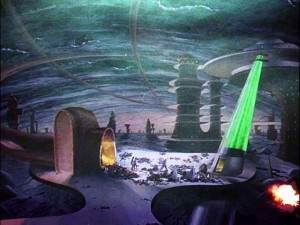
5. This Island Earth (1955) (Mystery Science Theater 3000: The Movie, 1996)
For Mystery Science Theater 3000: The Movie, a film beloved by generations of science fiction film fans was inexplicably selected for Mike and the Bots: the big-budget, special effects-laden Universal effort This Island Earth (1955).
This Island Earth revolves around scientists of the 1950s — the dawn of the “push button age” — being recruited by aliens from Metaluna to help in their war against the dreadful Zahgons. The film’s expressive imagery includes intergalactic space travel, and the ruthless bombardment of an alien metropolis. In terms of sets, visual effects, and pure scope, This Island Earth is hardly the typical “bad” movie fare of MST-3K history (think: Bride of the Monster).
Film scholar Gary Westfahl called This Island Earth “so distinctive, so haunting, and so difficult for critics to approach” in his book, Science Fiction, Children’s Literature and Popular Culture: Coming of Age in Fantasyland (2000), and Kenneth Von Gunden and Stuart H. Stock named the film one of the genre’s twenty best in 1982, in Twenty All-Time Great Science Fiction Films. The authors there opined that This Island Earth was a “rousing success.”
In terms of theme, the 1955 film plays as something like a metaphor for World War II. The movie’s scientists are essentially Americans recruited to by a benevolent foreign power (representing Europe) during a time of strife. The destruction of Metaluna is an allegory for Germany’s bombing of London — the Blitz — and the overall message is one of cooperation and involvement over isolation. If Exeter (Jeff Morrow) had been able to involve the scientists like Cal Meacham (Rex Reason) sooner, his world might have been saved from total ruin.
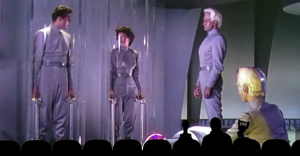
The great thing about Mystery Science Theater 3000 is that it manages to be incredibly funny even when the movies it skewers are not necessarily that awful. There’s no sense being precious about this: the point of the series is to have a good laugh about the movies, and MST-3K universally delivers.
But in the case of Phase IV, Moon Zero Two, Hangar 18, Gorgo and This Island Earth, it seems that the creators of the show didn’t really highlight — as the theme song promised — “the worst” movies the Mads could find, but rather, perhaps, the ones that happened to be available.
After all, the five movies listed above are certainly no Monster a Go-Go (1965)…
Would you like to support Flashbak?
Please consider making a donation to our site. We don't want to rely on ads to bring you the best of visual culture. You can also support us by signing up to our Mailing List. And you can also follow us on Facebook, Instagram and Twitter. For great art and culture delivered to your door, visit our shop.

